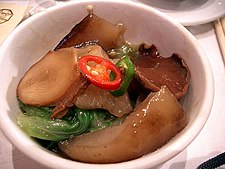Beche-de-Mer
| Sea cucumber | |||||||||||||||
 |
|||||||||||||||
| Chinese name | |||||||||||||||
|---|---|---|---|---|---|---|---|---|---|---|---|---|---|---|---|
| Traditional Chinese | |||||||||||||||
| Simplified Chinese | |||||||||||||||
| Hanyu Pinyin | hǎishēn | ||||||||||||||
| Literal meaning | sea ginseng | ||||||||||||||
|
|||||||||||||||
| Vietnamese name | |||||||||||||||
| Vietnamese | hải sâm | ||||||||||||||
| Transcriptions | |
|---|---|
| Standard Mandarin | |
| Hanyu Pinyin | hǎishēn |
| Yue: Cantonese | |
| Jyutping | hoi2 sam1 |
| Southern Min | |
| Hokkien POJ | hái-sam hái-sim hái-sum |
Sea cucumbers are marine animals of the class Holothuroidea. They are used in fresh or dried form in various cuisines. In some cultural contexts the sea cucumber is thought to have medicinal value.
The creature and the food product are commonly known as bêche-de-mer (literally "sea-spade") in French, trepang (or trīpang) in Indonesian, namako in Japanese, balatan in Tagalog and loli in Hawaiian. In Malay, it is known as the gamat.
Most cultures in East and Southeast Asia regard sea cucumbers as a delicacy. A number of dishes are made with sea cucumber, and in most dishes it has a slippery texture. Common ingredients that go with sea cucumber dishes include winter melon, conpoy, kai-lan, shiitake mushroom, and Chinese cabbage.
Sea cucumbers destined for food are traditionally harvested by hand from small watercraft, a process called "trepanging" after the Indonesian trepang). They are dried for preservation, and must be rehydrated by boiling and soaking in water for several days. They are mainly used as an ingredient in Chinese cuisine soups or stews.
Many commercially important species of sea cucumber are harvested and dried for export for use in Chinese cuisine as 海参 (hai shen in sound). Some of the more commonly found species in markets include:
Western Australia has sea cucumber fisheries from Exmouth to the border of the Northern Territory; almost all of the catch is sandfish (Holothuria scabra). The fishing of the various species known as bêche-de-mer is regulated by state and federal legislation.
...
Wikipedia
